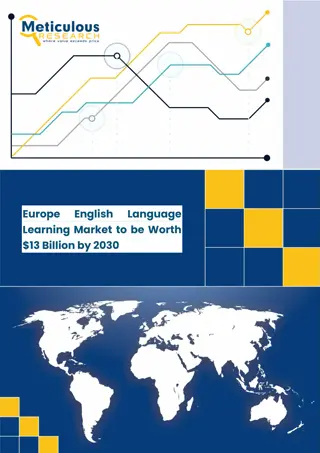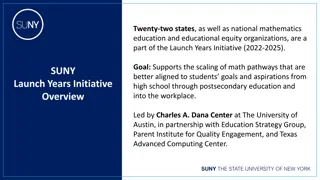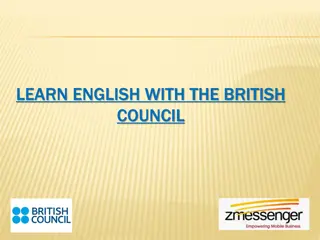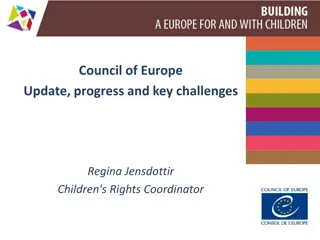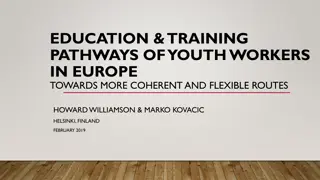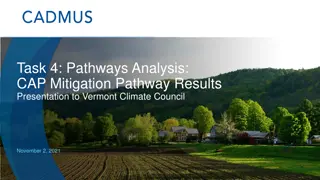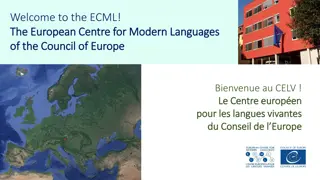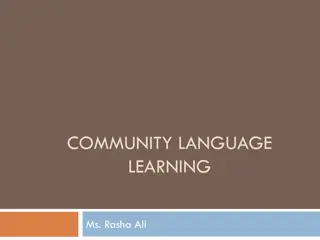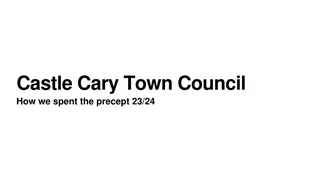Council of Europe Perspectives on Language Learning Pathways
Explore the Council of Europe's initiatives and values in language education, focusing on language learning pathways, the CEFR's perspective, implications for teaching curricula, and social inclusion. Discover how the Council promotes autonomous learning, critical thinking, and cultural diversity through its key projects.
Download Presentation

Please find below an Image/Link to download the presentation.
The content on the website is provided AS IS for your information and personal use only. It may not be sold, licensed, or shared on other websites without obtaining consent from the author. Download presentation by click this link. If you encounter any issues during the download, it is possible that the publisher has removed the file from their server.
E N D
Presentation Transcript
The European Centre for Modern Languages of the Council of Europe Language Learning Pathways: Towards a common understanding
Language learning pathway: two definitions 1. An individual s trajectory of language learning any number of languages may or may not be needs-driven/self-directed any combination of formal, non-formal and informal learning development of different proficiency levels in different languages different patterns and priorities of use at different points in the lifespan 2. Progressions of language learning proposed by an education system or curriculum one, two or several languages may or may not be coherent may or may not correspond to learners needs may or may not seek to supplement formal with non-formal learning
Overview A Council of Europe perspective The CEFR s view of language learning Implications for Teaching Curricula and policy Conclusion: some points for reflection/discussion
Council of Europe and education Core values Human rights (European Convention on Human Rights, 1950) Democratic governance Rule of law Key concern: to promote social cohesion and social inclusion Accordingly, the Council of Europe s educational projects are designed to empower the individual by developing his/her capacity for autonomous learning and critical thinking prepare him/her to participate actively in the democratic process Note that the concept of responsible autonomy was already central to the Council of Europe s major adult education project of the 1970s (Janne 1977, Holec 1979)
Council of Europe and language education Key instrument: European Cultural Convention (1954) Purpose: promote mutual understanding and reciprocal appreciation of cultural diversity encourage study of the languages, history and civilization of the countries that are party to the Convention Accordingly, the Council s language education projects are designed to promote approaches to teaching and learning that meet the individual learner s communicative needs develop language learning skills that can be deployed outside and after formal education encourage lifelong language learning
The concept of plurilingualism as an individual person s experience of language in its cultural contexts expands, from the language of the home to that of society at large and then to the languages of other peoples (whether learnt at school or college, or by direct experience), he or she does not keep these languages and cultures in strictly separated mental compartments, but rather builds up a communicative competence to which all knowledge and experience of language contributes and in which languages interrelate and interact (CEFR 1.3; Council of Europe 2001, p. 4)
From the Council of Europes perspective An individual s language learning pathway(s) should reflect his/her needs over the lifespan cannot be predicted because needs are unpredictable should result in an integrated plurilingual repertoire Education systems support individual learning by adopting policies and developing curricula that allow learners to follow different learning pathways according to their needs and interests fostering pedagogical approaches that develop skills of language learning that learners can use throughout their lives to navigate whatever learning paths present themselves
The CEFRs view of language learning
Language learning as language use Language use, embracing language learning, comprises the actions performed by persons who as individuals and as social agents develop a range of competences, both general and in particular communicative language competences. They draw on the competences at their disposal in various contexts under various conditions and under various constraints to engage in language activities involving language processes to produce and/or receive texts in relation to themes in specific domains, activating those strategies which seem most appropriate for carrying out the tasks to be accomplished. The monitoring of these actions by the participants leads to the reinforcement or modification of their competences (CEFR 2.1; Council of Europe 2001: 9; emphasis in original)
Language learning as language use Language use, embracing language learning, comprises the actions performed by persons who as individuals and as social agents develop a range of competences, both general and in particular communicative language competences. They draw on the competences at their disposal in various contexts under various conditions and under various constraints to engage in language activities involving language processes to produce and/or receive texts in relation to themes in specific domains, activating those strategies which seem most appropriate for carrying out the tasks to be accomplished. The monitoring of these actions by the participants leads to the reinforcement or modification of their competences (CEFR 2.1; Council of Europe 2001: 9; emphasis in original)
Language learning as language use Language use, embracing language learning, comprises the actions performed by persons who as individuals and as social agents develop a range of competences, both general and in particular communicative language competences. They draw on the competences at their disposal in various contexts under various conditions and under various constraints to engage in language activities involving language processes to produce and/or receive texts in relation to themes in specific domains, activating those strategies which seem most appropriate for carrying out the tasks to be accomplished. The monitoring of these actions by the participants leads to the reinforcement or modification of their competences (CEFR 2.1; Council of Europe 2001: 9; emphasis in original)
Implications for teaching, curricula and policy
Teaching The description of language proficiency as language use implies that the target language should be the principal channel of learning A language enters our plurilingual repertoire only if it is part of our everyday lived language (Garc a 2017) The method used should give learners the opportunity to exercise initiative in their learning ( social agents , monitoring ) If the target language is the principal channel of learning, monitoring that is at first intentional and explicit should gradually become involuntary and implicit, leading to the development of metacognitive proficiency Intentional and explicit monitoring = reflective learning Reflective learning is driven by self-assessment
Teaching The CEFR s description of language learning as a variety of language use and the language user-learner as an autonomous social agent encourages a more radical view of language learner autonomy than learning how to learn This more radical view entails learning in which, from the beginning, the target language is the principal channel of the learners agency: the communicative and metacognitive medium through which, individually and collaboratively, they plan, execute, monitor and evaluate their own learning This view is elaborated at length with reference to theory, classroom practice and research by Little, Dam & Legenhausen (2017)
Curricula and policy should Explicitly adopt the Council of Europe s perspective on education/language education Explicitly embody the CEFR s definition of language learning as language use Empower teachers to develop their learners capacity to exercise agency in and through the target language reflective learning, self- and peer-assessment Foster continuity of criteria from self- and peer-assessment, through teacher/school-based assessment to external exams Provide for teaching and learning that bring the various languages of the curriculum into interaction with one another
Some points for reflection/discussion How well known are the Council of Europe s core values and key concerns in your context? Does the curriculum you follow focus specifically on the development of communicative proficiency? take account of learners needs? seek to develop the agency of the individual learner? In your context Is the development of plurilingualism an explicit curriculum goal? What role does spontaneous language use play in formal language learning? How is learner autonomy (i) understood and (ii) developed?
Some points for reflection/discussion How well known are the Council of Europe s core values and key concerns in your context? Does the curriculum you follow focus specifically on the development of communicative proficiency? take account of learners needs? seek to develop the agency of the individual learner? In your context Is the development of plurilingualism an explicit curriculum goal? What role does spontaneous language use play in formal language learning? How is learner autonomy (i) understood and (ii) developed? Task for group work Bearing these questions in mind, draw up a list of issues to be discussed and challenges to be met




